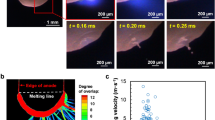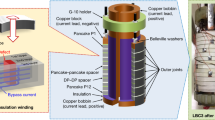Abstract
IF a normal vacuum arc is struck between a liquid mercury cathode and a vertical thin tungsten wire anode a most unusual discharge may be obtained. The anode wire must be of such a diameter as to become red-hot when the arc has started and its lower (unsupported) end must then be lowered slowly toward the cathode pool. The tip of the hot wire makes a dimple in the liquid surface and the arc immediately transfers to within this dimple, the evolution of vapour from the cathode spot giving rise to sufficient hydrostatic pressure to prevent metallic contact from anode to cathode.
This is a preview of subscription content, access via your institution
Access options
Subscribe to this journal
Receive 51 print issues and online access
$199.00 per year
only $3.90 per issue
Buy this article
- Purchase on Springer Link
- Instant access to full article PDF
Prices may be subject to local taxes which are calculated during checkout
Similar content being viewed by others
References
Froome, K. D., Proc. Phys. Soc., B, 62, 805 (1949).
Lamar, E. S., and Compton, K. J., Phys. Rev., 37, 1069 (1931).
Gaudenzi, A., Brown Boveri Rev., 16, 303 (1929).
Author information
Authors and Affiliations
Rights and permissions
About this article
Cite this article
FROOME, K. An 8-Volt Cold-Cathode Mercury Arc emitting Microwaves. Nature 179, 267–268 (1957). https://doi.org/10.1038/179267a0
Issue Date:
DOI: https://doi.org/10.1038/179267a0
This article is cited by
-
A New Microwave Harmonic Generator
Nature (1959)
Comments
By submitting a comment you agree to abide by our Terms and Community Guidelines. If you find something abusive or that does not comply with our terms or guidelines please flag it as inappropriate.



